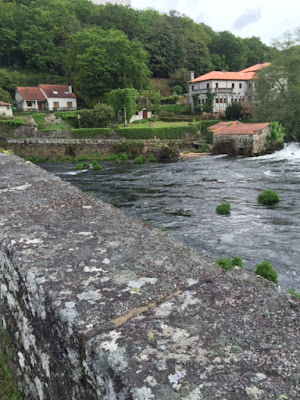The pilgrimage to Santiago de Compostella has different starting points and routes. The route we took, Camino Frances, is the most well-known. While Santiago is the most common ending point, in ancient times and even today, some pilgrims journey on another 50 miles to Finisterre (the end of the earth).
Finisterre is so named because before the Europeans discovered the New World it was literally considered the end of the world. On the map above, it is called Fisterra and Cabo Fisterra is where we went.
When pilgrims arrived, they would burn their clothes. Often they would pick up a shell as a souvenir. This may be the actual origin of the scallop shell as a symbol of the pilgrimage.
For centuries, people have come here to worship. The Druids came to pay homage to the sun. Here a woman meditates.
This area is also known as the Coast of Death. It is very rocky and there have been many shipwrecks. Also, it is where the sun goes to die each day. All ways, roads, and paths end here.
It was somewhat overcast and extremely windy the day were were there, adding to the feeling of being at the end of the earth.
Please don't fall in, John!
You either, Luke!
This was a powerful place. It is hard to convey how windy it was.
Maybe this will help.
Those rocks that so many ships crashed on? Granite. The Galicia region of Spain is filled with granite. The fences in the field are made of granite, the churches are made of granite. The very ground is made of granite. Galicia is the fifth largest exporter of granite in the world. If you have a granite countertop, the granite may have come from Galicia.
Luke and John at Camino de Santiago, Kilometer 0, at Finisterre, the end of the earth.
We also visited Puente Maceira, a village on the way to Finisterre.
The town has a bridge, constructed in the 13th or 14th century, according to Roman specs.
The water helped power the mills, which made flour.
Lots of Galician fishing villages on the Shore of Death.
This is part of Mt. Pindo, a mountain in Galicia. The mountain is considered to have magical properties. There are ruins of castles and oddly shaped granite boulders. The Celts thought of Mt. Pindo as their Mt. Olympus and there has been a human presence for at least 6,000 years. The Celts worshiped the sun on this mountain. I think the Disney ride, Magic Mountain, looks a little like this.
We visited the Ezaro Waterfall, which tumbles down Mt. Pindo. It is the largest waterfall in continental Europe that empties directly into the ocean.
Luke with our intrepid and very funny guide Reuben. Reuben did a great job. He should have a late night talk show.
Our last stop of the day was the coastal village of Muxia. The Spanish in Galicia is heavily influence by Portuguese. Muxia is pronounced Mooshe-a. The letter c is pronounced th so Galicia sounds like Galithia.
Muxia is an important town in the legend of St. James. After Jesus ascended into heaven. St. James (the Greater) came to Spain to evangelize the people. According to Reuben, the story goes that James was sitting at the shore here, despondent about his failure to convert the pagans. All of a sudden, the Virgin Mary appeared at sea in a boat made of granite (ships made of granite are common in Galician stories). She consoled St. James and told him not to worry.
The rocks at this site are supposedly the remnants of Mary's boat. Above is the sail.
Another legend has it that if you go under the sail nine times, your back problems will be cured.
One of these is the stern or rudder. I can't remember which.
Coastal Galicia--the Shore of Death--is a beautiful, holy place.








































No comments:
Post a Comment